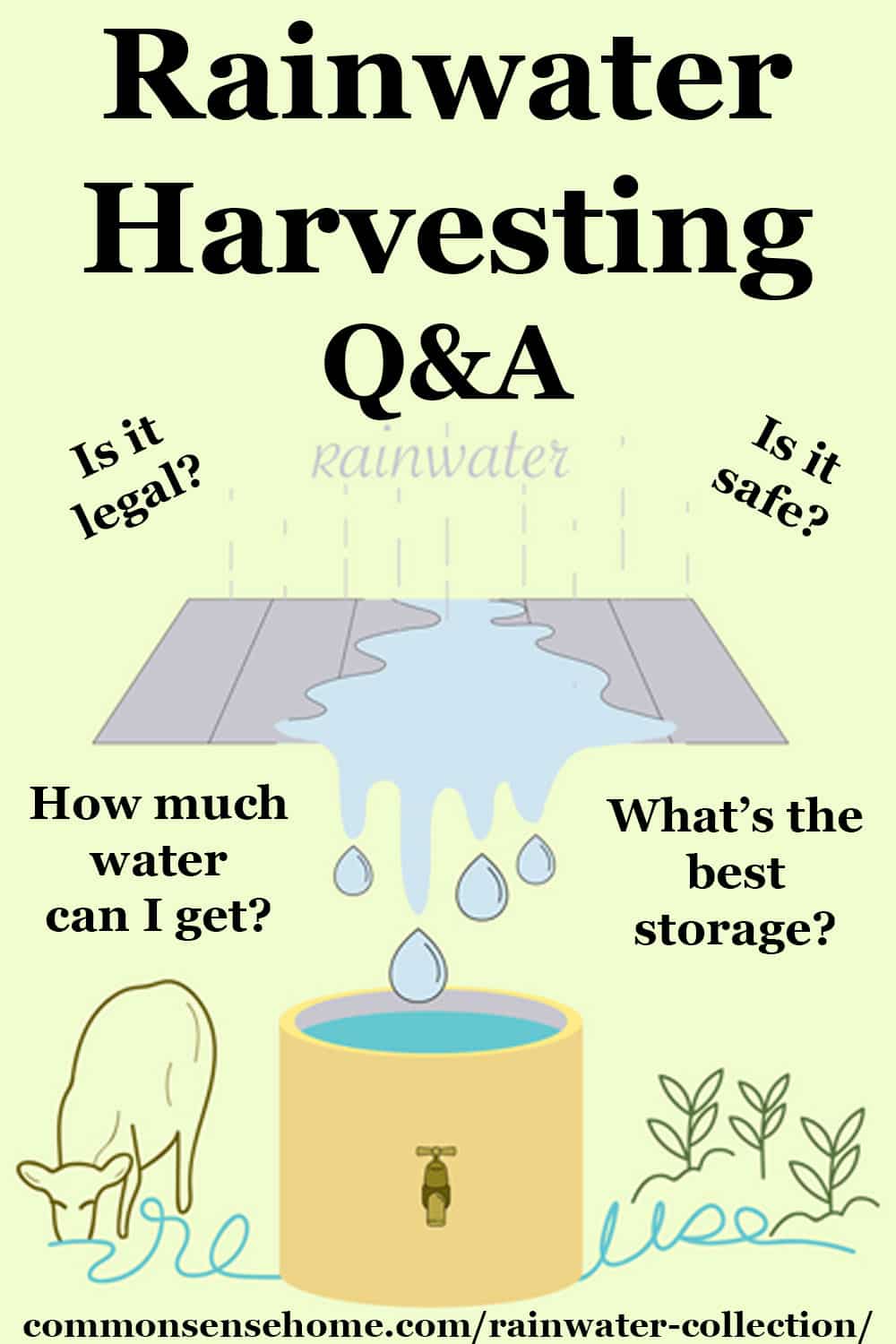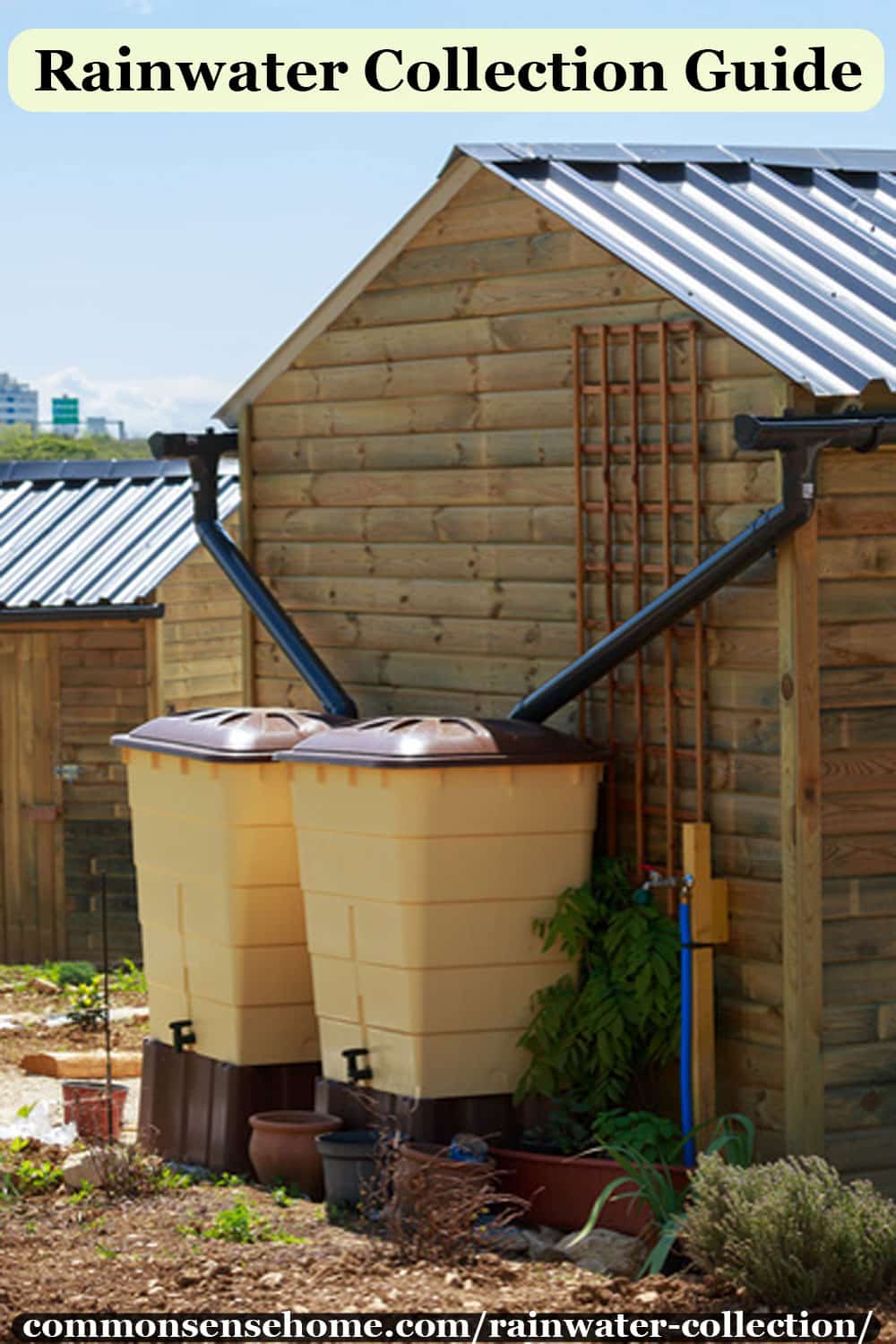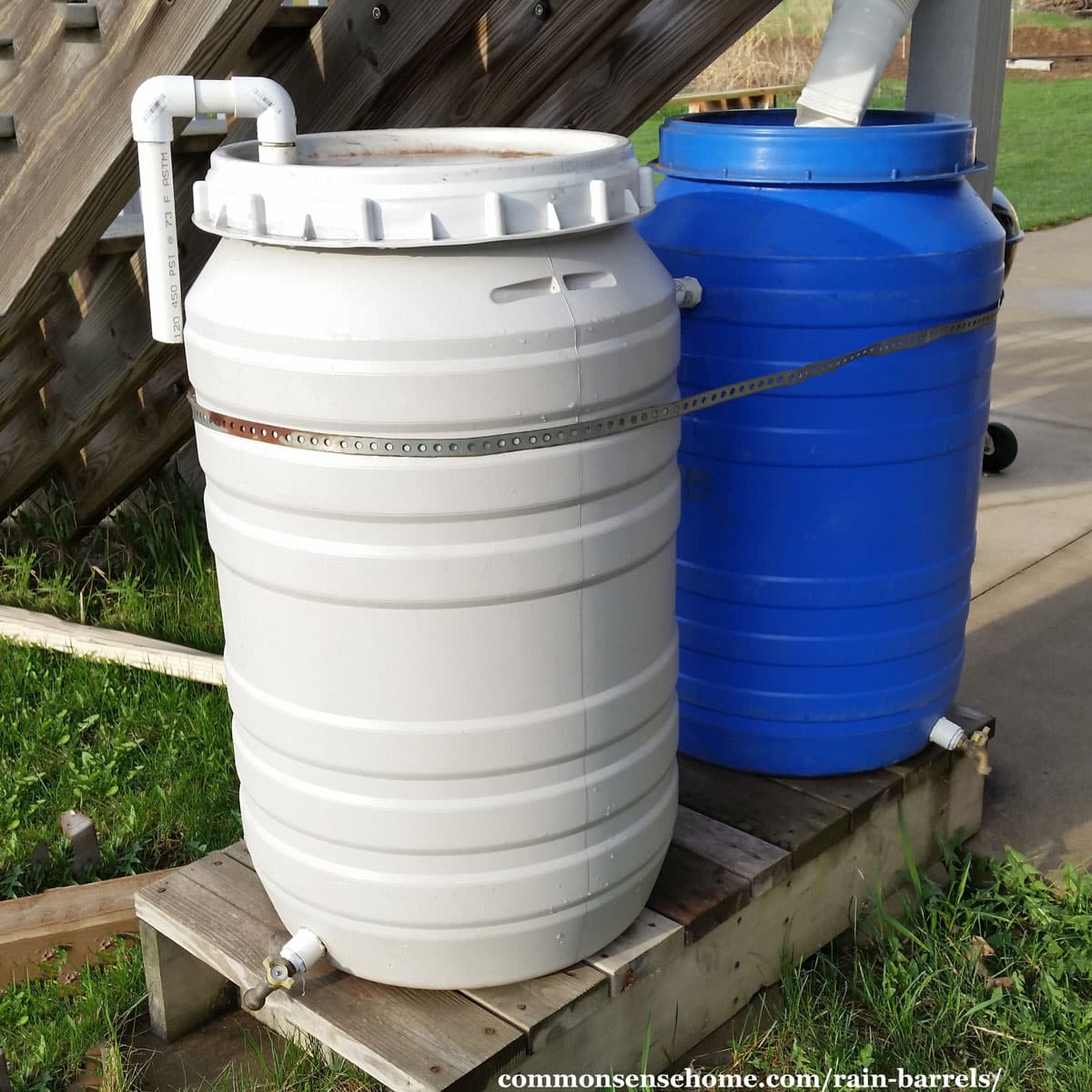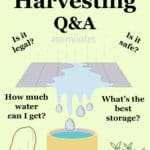Rainwater Collection Guide – Common Questions Answered
This post may contain affiliate links. Read my full disclosure here.
In this article, we’ll answer some of the most common questions about rainwater collection, storage and use.

What is rainwater collection?
Rainwater collection and harvesting gathers rainwater and keeps it on site for later use.
This water can be used to provide water for landscaping and gardens, in-home use, wildlife, livestock, fire protection, stormwater management and rain gardens.
Harvesting rainwater is a great way to control run off, conserve water and reduce your water bill. Rainwater lacks chlorine and fluoride that is found in many municipal water supplies.
Why is there a Need for Rainwater Collection?
Unlike many well water and municipal water supplies, rain water is naturally soft. Normal, clean rain has a pH of between 5.0 and 5.5.
If you’re willing to invest in a system to use harvested rainwater for your household needs, you can enjoy cleaner clothes and people, longer appliance life and no hard water buildup on fixtures and pipes.
In your garden, rainwater is the best option for watering. It’s free of salts and other minerals that can build up in the soil and harm your plants.
Where groundwater is poor quality or unavailable, rainwater recovery may be your most affordable option for clean, safe water for you, your garden and livestock.
In urban and suburban areas, much of the surface area is made up of impenetrable surfaces. These include roofs, sidewalks, driveways, streets, etc.. Rainwater falls and is swept into storm sewers instead of slowly percolating into the soil.
Combine rainwater collection with landscaping options such as rain gardens, and you have better storm water management. We keep water on site longer and release it slowly into the soil. This is extremely helpful during heavy rains.
Municipal water also tends to be expensive, and many municipal water supplies are under stress. If you replace some of your water use with a rainwater catchment system, it reduces demand and saves you money.

Is it legal to Collect Rainwater?
Some states do have specific laws on the books limiting rainwater harvesting or use. It’s best to check with your local regulations before making a big investment.
States with rainwater collection regulations include:
- Arizona
- Arkansas
- California
- Colorado
- Hawaii
- Illinois
- Nevada
- New Jersey
- North Carolina
- Ohio
- Oklahoma
- Oregon
- Rhode Island
- Texas
- Utah
- Virginia
- Washington
- U. S. Virgin islands
You can learn more at State Rainwater Harvesting Laws and Regulations.
Can I Drink Rainwater?
It is best to filter rainwater before using it for drinking water.
Gutters and downspouts collect leaves and other grime. The first water to come off the roof of your home when it rains has the most large debris, but rain drops form around dust. Even “clean” rainwater contains some dust particles.
For more information on potable water filtration see:
- Emergency Water Storage and Filtration – What you need to know before emergencies hit
- 3 Emergency Water Filters
How much rainwater will I collect?
There are online rainwater harvesting calculators, but here are the basics.
One square foot covered with water an inch deep equals 0.6233 gallons. That means that the amount of water you could harvest from a 1000 square foot roof from 1 inch of rain is up to 623 gallons .
Due to splashing and other losses, a more realistic number is about 550 gallons of rainwater harvested per inch of rain per 1000 square feet of collection surface.
As you can see, a good rain can fill a water barrel pretty quickly, so make sure to include an overflow for your rainwater collection system.
Rainwater Storage Containers – Rain Barrels and Cisterns
A key component of your rain water collection system is storage. Some ways to store rainwater include:
Would you like to save this?
- Water barrel this 55gal tank includes a screen and overflow which can be connected to a 2nd barrel
- IBC Tank will store 275 gallons, but you will need to add a filter and hose fitting
- Stone cistern or Concrete or Ferro-Cement Cisterns
- Metal Storage Tanks
- Plastic Storage Tanks
Rain Barrels
Water barrels are a great way to start with rainwater harvesting on a small scale. A rainwater barrel is relatively inexpensive, especially if you can find the barrels cheap or free. This is a good 58gal Water barrel that includes a filter, hose drain and overflow spout. It is slightly more expensive but comes ready to hook up.
For other rainwater barrel options see Rain Barrels – DIY, Cheap, Decorative Options (Plus Care Tips) for instructions how to build and care for a rain barrel. It will require that you can find old food grade barrels from a restaurant or other food related business.
Intermediate Bulk Container (IBC) Tanks
The IBC can store up to 275 gallons. It is not purpose built for rainwater collection but is large and fittings are readily available to convert it to rainwater use.
You can stack IBC totes. If you choose to, you will want to ensure they have the metal base. We recommend you purchase them locally from a farm supply store. You will need additional fittings also.
Stone Cistern
Many old farmhouses and homes had underground stone cisterns. Stone cisterns are beautiful, but they are difficult to maintain and cost prohibitive to build new. Newer cisterns are built using concrete or ferro-cement. Contact a local provider for installation.
Plastic and Fiberglass tanks
Fiberglass cisterns are durable, UV resistant (which inhibits algae growth), and budget friendly. They can be painted with household latex paint to create a decorative rainwater cistern. These cisterns and tanks come above ground and some may be installed below ground.
To purchase larger rainwater polypropylene or fiberglass water storage tanks, check with farm supply or industrial supply stores. Most will require modification to use but these can be 1000+ gallon tanks.

Other Rainwater Collection and Storage options
Underground water tanks (also called cisterns) are an option. If they are installed wrong they and there is water in the soil, they can float up out of the ground creating a huge mess.
Underground tanks store between several hundred and 20,000+ gallons. They are expensive, ranging in price from around $1000 to over $10,000. In nearly all cases, they require permits and contractors to install.
If you want to learn more about how to design a rainwater harvesting system, plans for roof washing systems, and just about any other questions you may have on rainwater collection for household use, I recommend the book “Rainwater Collection for the Mechanically Challenged“. Another good reference is Essential Rainwater Harvesting.
Be Careful – Water is Heavy
Recently, I’ve seen a photo of a rainwater collection system featuring three 55 gallon plastic drums, stacked on their side, one above the other, in a wooden frame with PVC connections. I don’t recommend that rain barrel system, and I’ll explain why.
Those plastic drums are heavy, and the PVC connections are hard piped. Once installed, it would be a bear to get in there and clean your barrels which you should do annually.
If you have full rain barrels, they could contain over 1200 pounds of water. I don’t trust that the structure in most of these DIY solutions, is sturdy enough to hold the barrels.
Many DIY designs use garbage cans to make a rain barrel. I don’t recommend that, because garbage cans are not built to stand around full of water, and chemicals may leach out of the plastic.
Sooner rather than later, that garbage can rain barrel will end up as garbage itself.
Do you Collect Rainwater?
Do you have rain barrels or another rainwater harvesting system? I’d love to learn more from those who use rainwater for household and livestock use.
So far we have 100 gallons of storage that we use seasonally, but I hope to add more moving forward.
More Gardening, Homesteading and Green Living Ideas
Check out the Gardening, Homesteading, and Green Home index pages for more ideas and inspiration, including:




Hi,
Water was the first consideration of my attempts to be resilient to factors over which we have no control. We now have about 600 gallons of rainwater storage and successfully tested purification methods that require no power. This was accomplished over time under a rather tight budget that ended up costing about two dollars per storage gallon.
I’ll be happy to share our system with your readers.
Regards